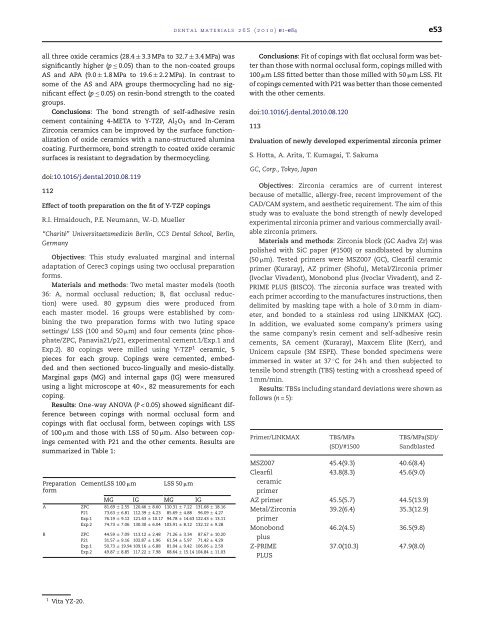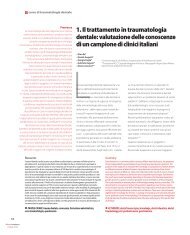Abstracts of the Academy of Dental Materials Annual ... - IsiRed
Abstracts of the Academy of Dental Materials Annual ... - IsiRed
Abstracts of the Academy of Dental Materials Annual ... - IsiRed
You also want an ePaper? Increase the reach of your titles
YUMPU automatically turns print PDFs into web optimized ePapers that Google loves.
all three oxide ceramics (28.4 ± 3.3 MPa to 32.7 ± 3.4 MPa) was<br />
significantly higher (p ≤ 0.05) than to <strong>the</strong> non-coated groups<br />
AS and APA (9.0 ± 1.8 MPa to 19.6 ± 2.2 MPa). In contrast to<br />
some <strong>of</strong> <strong>the</strong> AS and APA groups <strong>the</strong>rmocycling had no significant<br />
effect (p ≤ 0.05) on resin-bond strength to <strong>the</strong> coated<br />
groups.<br />
Conclusions: The bond strength <strong>of</strong> self-adhesive resin<br />
cement containing 4-META to Y-TZP, Al2O3 and In-Ceram<br />
Zirconia ceramics can be improved by <strong>the</strong> surface functionalization<br />
<strong>of</strong> oxide ceramics with a nano-structured alumina<br />
coating. Fur<strong>the</strong>rmore, bond strength to coated oxide ceramic<br />
surfaces is resistant to degradation by <strong>the</strong>rmocycling.<br />
doi:10.1016/j.dental.2010.08.119<br />
112<br />
Effect <strong>of</strong> tooth preparation on <strong>the</strong> fit <strong>of</strong> Y-TZP copings<br />
R.I. Hmaidouch, P.E. Neumann, W.-D. Mueller<br />
“Charité” Universitaetsmedizin Berlin, CC3 <strong>Dental</strong> School, Berlin,<br />
Germany<br />
Objectives: This study evaluated marginal and internal<br />
adaptation <strong>of</strong> Cerec3 copings using two occlusal preparation<br />
forms.<br />
<strong>Materials</strong> and methods: Two metal master models (tooth<br />
36: A, normal occlusal reduction; B, flat occlusal reduction)<br />
were used. 80 gypsum dies were produced from<br />
each master model. 16 groups were established by combining<br />
<strong>the</strong> two preparation forms with two luting space<br />
settings/ LSS (100 and 50 �m) and four cements (zinc phosphate/ZPC,<br />
Panavia21/p21, experimental cement.1/Exp.1 and<br />
Exp.2). 80 copings were milled using Y-TZP 1 ceramic, 5<br />
pieces for each group. Copings were cemented, embedded<br />
and <strong>the</strong>n sectioned bucco-lingually and mesio-distally.<br />
Marginal gaps (MG) and internal gaps (IG) were measured<br />
using a light microscope at 40×, 82 measurements for each<br />
coping.<br />
Results: One-way ANOVA (P < 0.05) showed significant difference<br />
between copings with normal occlusal form and<br />
copings with flat occlusal form, between copings with LSS<br />
<strong>of</strong> 100 �m and those with LSS <strong>of</strong> 50 �m. Also between copings<br />
cemented with P21 and <strong>the</strong> o<strong>the</strong>r cements. Results are<br />
summarized in Table 1:<br />
Preparation<br />
form<br />
CementLSS 100 �m LSS 50 �m<br />
MG IG MG IG<br />
A ZPC 81.69 ± 2.55 120.46 ± 8.60 110.31 ± 7.22 131.68 ± 18.16<br />
P21 73.63 ± 6.81 112.39 ± 4.23 85.69 ± 4.88 96.09 ± 4.27<br />
Exp.1 76.19 ± 9.12 121.43 ± 10.17 94.78 ± 14.63 122.43 ± 13.11<br />
Exp.2 74.73 ± 7.06 130.30 ± 6.04 103.91 ± 8.12 132.12 ± 9.28<br />
B ZPC 44.59 ± 7.09 113.12 ± 2.48 71.26 ± 3.34 87.67 ± 10.20<br />
P21 31.57 ± 9.16 102.87 ± 1.96 61.54 ± 5.97 71.42 ± 4.29<br />
Exp.1 50.73 ± 19.94 109.16 ± 6.88 81.04 ± 9.42 106.06 ± 2.59<br />
Exp.2 49.87 ± 8.85 117.22 ± 7.98 68.64 ± 15.14 104.84 ± 11.03<br />
1 Vita YZ-20.<br />
dental materials 26S (2010) e1–e84 e53<br />
Conclusions: Fit <strong>of</strong> copings with flat occlusal form was better<br />
than those with normal occlusal form, copings milled with<br />
100 �m LSS fitted better than those milled with 50 �m LSS. Fit<br />
<strong>of</strong> copings cemented with P21 was better than those cemented<br />
with <strong>the</strong> o<strong>the</strong>r cements.<br />
doi:10.1016/j.dental.2010.08.120<br />
113<br />
Evaluation <strong>of</strong> newly developed experimental zirconia primer<br />
S. Hotta, A. Arita, T. Kumagai, T. Sakuma<br />
GC, Corp., Tokyo, Japan<br />
Objectives: Zirconia ceramics are <strong>of</strong> current interest<br />
because <strong>of</strong> metallic, allergy-free, recent improvement <strong>of</strong> <strong>the</strong><br />
CAD/CAM system, and aes<strong>the</strong>tic requirement. The aim <strong>of</strong> this<br />
study was to evaluate <strong>the</strong> bond strength <strong>of</strong> newly developed<br />
experimental zirconia primer and various commercially available<br />
zirconia primers.<br />
<strong>Materials</strong> and methods: Zirconia block (GC Aadva Zr) was<br />
polished with SiC paper (#1500) or sandblasted by alumina<br />
(50 �m). Tested primers were MSZ007 (GC), Clearfil ceramic<br />
primer (Kuraray), AZ primer (Sh<strong>of</strong>u), Metal/Zirconia primer<br />
(Ivoclar Vivadent), Monobond plus (Ivoclar Vivadent), and Z-<br />
PRIME PLUS (BISCO). The zirconia surface was treated with<br />
each primer according to <strong>the</strong> manufactures instructions, <strong>the</strong>n<br />
delimited by masking tape with a hole <strong>of</strong> 3.0 mm in diameter,<br />
and bonded to a stainless rod using LINKMAX (GC).<br />
In addition, we evaluated some company’s primers using<br />
<strong>the</strong> same company’s resin cement and self-adhesive resin<br />
cements, SA cement (Kuraray), Maxcem Elite (Kerr), and<br />
Unicem capsule (3M ESPE). These bonded specimens were<br />
immersed in water at 37 ◦ C for 24 h and <strong>the</strong>n subjected to<br />
tensile bond strength (TBS) testing with a crosshead speed <strong>of</strong><br />
1 mm/min.<br />
Results: TBSs including standard deviations were shown as<br />
follows (n = 5):<br />
Primer/LINKMAX TBS/MPa<br />
(SD)/#1500<br />
TBS/MPa(SD)/<br />
Sandblasted<br />
MSZ007 45.4(9.3) 40.6(8.4)<br />
Clearfil<br />
ceramic<br />
primer<br />
43.8(8.3) 45.6(9.0)<br />
AZ primer 45.5(5.7) 44.5(13.9)<br />
Metal/Zirconia<br />
primer<br />
39.2(6.4) 35.3(12.9)<br />
Monobond<br />
plus<br />
46.2(4.5) 36.5(9.8)<br />
Z-PRIME<br />
PLUS<br />
37.0(10.3) 47.9(8.0)



